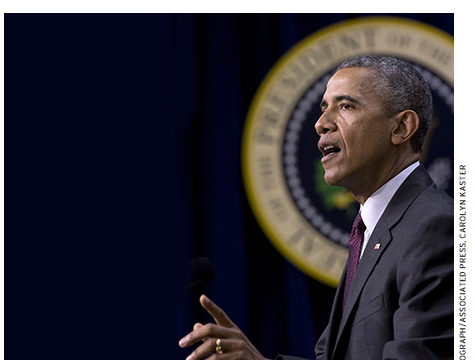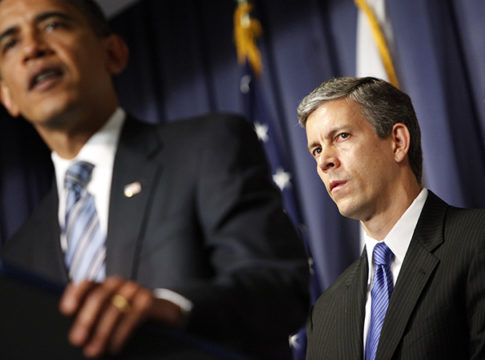 President Obama and Education Reform: The Personal and the Political
President Obama and Education Reform: The Personal and the Political
By Robert Maranto and Michael Q. McShane
Palgrave Macmillan, 2012, $28; 256 pages.
As reviewed by Nathan Glazer
This book, and this review, will be published while the presidential campaign is in full swing, and whether there will be anything more to be said about President Obama’s efforts at education reform, still fragmentary now, depends on the outcome of the election. President Obama and Education Reform was written when there was really only half a presidential term to evaluate: after the midterm elections of 2010, there was nothing the administration could do that was in any way dependent on Congress, and even the long-delayed effort to reauthorize the primary basis of the federal role in education, the Elementary and Secondary Education Act, it was clear, would have to be delayed further, perhaps to the next administration.
Nevertheless, there is still a story to be told, and the essential part of it is that the program that education reformers have tried to promote now for decades—introduce more choices of schools for students, enable competition among schools, open up paths for preparing teachers and administrators outside schools of education, improve measures of student achievement and teacher competence, enable administrators to act on the basis of such measures, and limit the power of teachers unions—has been advanced under the Obama administration, in the judgment of authors Maranto and McShane.
They are political scientists steeped in the discipline’s current theories and methods, and there will be somewhat more of this than I think most readers will want. The authors are well aware of the limitation our complex political system places on any effort at change and reform, and in view of this complexity, they do not expect much: if some policy does more good than harm, that is good enough for them. They describe themselves as a “centrist conservative” and a “centrist liberal,” and one should expect neither enthusiasm nor denunciation from them. They differentiate themselves from those “progressive academics…who see the Obama reforms as destroying American schools” or those who see them “as shoring up a defunct system.” They appreciate that as a Democratic president Obama has had to act against the firmly held positions of major supporters of the Democratic Party, the teachers unions, but note that there are limits to how far he will go: yes to including data on effectiveness in teacher evaluations, no to providing private school vouchers for students in the District of Columbia. But Obama has certainly gone much further in the direction of reform than Hillary Clinton would have as president.
Noting how long it takes to introduce any major policy in our system, the authors divide presidents, following political scientist Michael Nelson, between “presidents of preparation” and “presidents of achievement.” Among the first they place Reagan, George H. W. Bush, and Clinton. Among the latter is George W. Bush, because of No Child Left Behind, and possibly Barack Obama: “We think it likely [his] reform will make him a second president of achievement.” This is not because of any major legislative accomplishment, but because of the significant changes attributable to Race to the Top (RttT), the primary education-reform move of the Obama administration.
There is not much to go on in view of the limited time during which RttT has been in effect, and the even more limited time available to judge the effectiveness of the substantial sums disbursed to winning states. (The sum is “substantial” in one respect, at $4 billion, minor in another, compared to $80 billion to sustain teachers’ employment in the stimulus act, or to the total sums spent at state and local levels for schools and teachers.) The key point is that RttT rewarded states on the basis of how far they went in certain directions favored by education reformers. A good number of states changed their laws to permit administrators to use measures of teacher effectiveness in judging teacher competence, which has been a no-no to the teachers unions. This is in itself a remarkable accomplishment.
Maranto and McShane emphasize the strong push in Race to the Top in the direction of national standards. While the law establishing the Department of Education forbids the federal government to “exercise any direction, supervision, or control over the curriculum, program of instruction, or administration or personnel of any educational institution…,” in Race to the Top, “the Obama administration tacitly gave its approval to a set of ‘Common Core Standards’ developed by a consortium of state school officers and tied Race to the Top dollars to participation in the program.” This may be a path to finally getting a set of national standards and overriding the standards the states set, which have in many states been pushed lower. This “race to the bottom” has made it easier to show adequate yearly progress (AYP) and avoid triggering measures required for schools that do not show AYP.
Despite alternative tendencies in academic political science, Maranto and McShane take seriously the role and motivation of the president in making policy, as against the requirements and restrictions of the larger forces affecting policymaking. (Note the book’s subtitle, “The Personal and the Political.”) Thus the authors review in detail the educational experiences and points of view of the last President Bush and President Obama, and they would argue that neither No Child Left Behind nor Race to the Top were written in the cards: the programs were specifically shaped by presidents whose own educational experiences demonstrated to them the need for effort and judgment. (Think of young George Bush, coming from a lax Texas school to the rigors of Phillips Andover, which he strained to meet, or young Barack Obama being awakened early in the morning by his mother in Indonesia so he could master the curriculum he would face once back in the United States.)
I should note that the “Education Industrial Complex,” or EIC, plays a large role in this book as the uniform enemy of school reform. The authors quote Jeanne Allen, president of the Center for Education Reform, as describing this as “more than 200 associations, federations, alliances, departments, offices, administrations, councils, boards, commissions, panels, organizations, herds, flocks, and coveys….” This makes too much of an amalgam, including everyone within education. Surely here and there are supporters of some of the measures the reformers, and Maranto and McShane, favor, and more differentiation would have been desirable.
Maranto and McShane conclude by noting four large forces that will shape the future of education and its funding: the increasing number and percentage of the aged, putting pressure on all other public functions, primarily because of the cost of medical care; the rise of the ”creative class,” as described by urban theorist Richard Florida, as those who work with ideas and demand more from teachers and schools; the new technology for education, rivaling and undermining traditional approaches and structures; and advances in measurement of achievement and competence, making the failings of current schools and educational approaches more apparent. This makes for a sobering future for traditional education: it will not be able to count on more public resources, and ideas will become more important than ever. Clearly, despite NCLB and Race to the Top, we are only at the beginning of an age of reform in education, whoever comes out ahead in the election.
Nathan Glazer is professor emeritus of sociology and education at Harvard University.
This article appeared in the Fall 2012 issue of Education Next. Suggested citation format:
Glazer, N. (2012). Grading the President: With Race to the Top, Obama earns a B+ in ed reform. Education Next, 12(4), 89-91.




